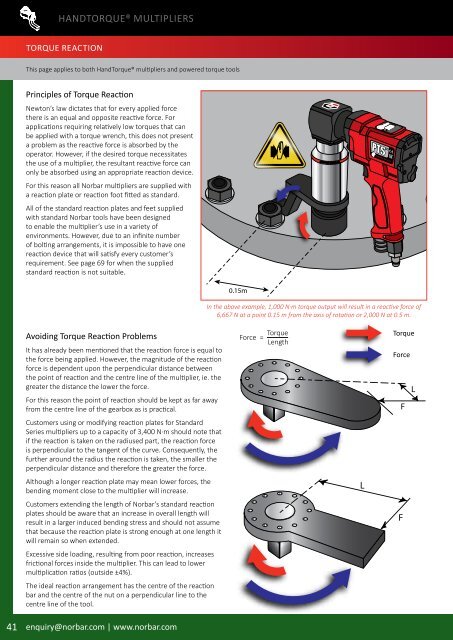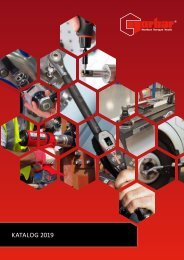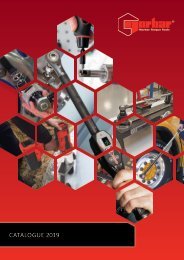Norbar Catalogue 2019
Torque Tool and equipment catalogue from Norbar Torque Tools
Torque Tool and equipment catalogue from Norbar Torque Tools
You also want an ePaper? Increase the reach of your titles
YUMPU automatically turns print PDFs into web optimized ePapers that Google loves.
HANDTORQUE® MULTIPLIERS<br />
TORQUE REACTION<br />
This page applies to both HandTorque® multipliers and powered torque tools<br />
Principles of Torque Reaction<br />
Newton’s law dictates that for every applied force<br />
there is an equal and opposite reactive force. For<br />
applications requiring relatively low torques that can<br />
be applied with a torque wrench, this does not present<br />
a problem as the reactive force is absorbed by the<br />
operator. However, if the desired torque necessitates<br />
the use of a multiplier, the resultant reactive force can<br />
only be absorbed using an appropriate reaction device.<br />
For this reason all <strong>Norbar</strong> multipliers are supplied with<br />
a reaction plate or reaction foot fitted as standard.<br />
All of the standard reaction plates and feet supplied<br />
with standard <strong>Norbar</strong> tools have been designed<br />
to enable the multiplier’s use in a variety of<br />
environments. However, due to an infinite number<br />
of bolting arrangements, it is impossible to have one<br />
reaction device that will satisfy every customer’s<br />
requirement. See page 69 for when the supplied<br />
standard reaction is not suitable.<br />
0.15m<br />
In the above example, 1,000 N·m torque output will result in a reactive force of<br />
6,667 N at a point 0.15 m from the axis of rotation or 2,000 N at 0.5 m.<br />
Avoiding Torque Reaction Problems<br />
It has already been mentioned that the reaction force is equal to<br />
the force being applied. However, the magnitude of the reaction<br />
force is dependent upon the perpendicular distance between<br />
the point of reaction and the centre line of the multiplier, ie. the<br />
greater the distance the lower the force.<br />
For this reason the point of reaction should be kept as far away<br />
from the centre line of the gearbox as is practical.<br />
Customers using or modifying reaction plates for Standard<br />
Series multipliers up to a capacity of 3,400 N·m should note that<br />
if the reaction is taken on the radiused part, the reaction force<br />
is perpendicular to the tangent of the curve. Consequently, the<br />
further around the radius the reaction is taken, the smaller the<br />
perpendicular distance and therefore the greater the force.<br />
Although a longer reaction plate may mean lower forces, the<br />
bending moment close to the multiplier will increase.<br />
Customers extending the length of <strong>Norbar</strong>’s standard reaction<br />
plates should be aware that an increase in overall length will<br />
result in a larger induced bending stress and should not assume<br />
that because the reaction plate is strong enough at one length it<br />
will remain so when extended.<br />
Excessive side loading, resulting from poor reaction, increases<br />
frictional forces inside the multiplier. This can lead to lower<br />
multiplication ratios (outside ±4%).<br />
The ideal reaction arrangement has the centre of the reaction<br />
bar and the centre of the nut on a perpendicular line to the<br />
centre line of the tool.<br />
41 enquiry@norbar.com | www.norbar.com<br />
Force = Torque<br />
Length<br />
L<br />
Torque<br />
Force<br />
L<br />
F<br />
F







